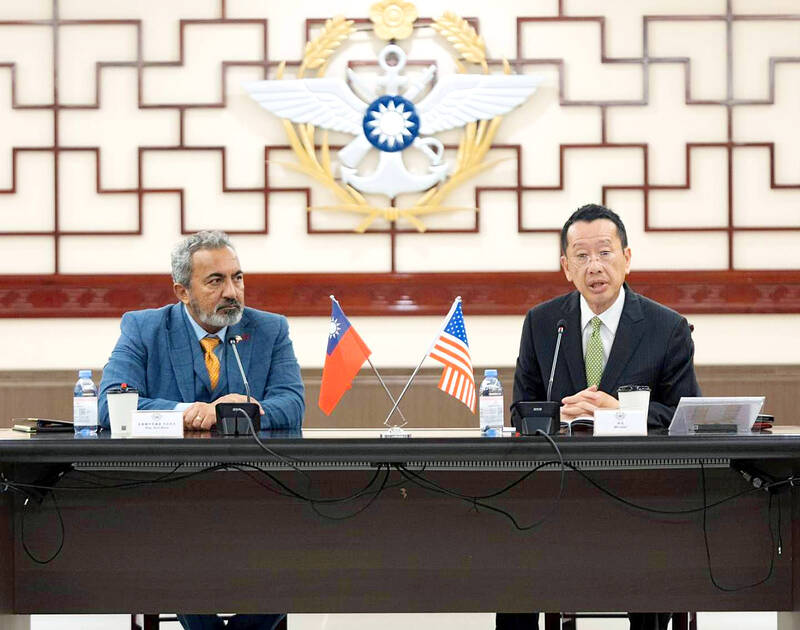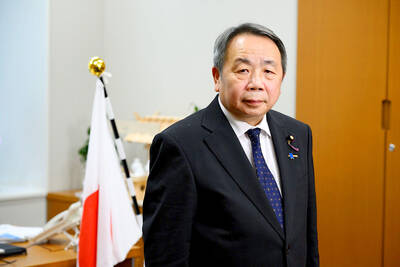A group of US lawmakers held a rare publicly disclosed meeting with Taiwan’s top defense official, a discussion that risks spurring China to step up its military intimidation of the democracy.
The delegation, led by US Representative Ami Bera from California, met with Minister of National Defense Wellington Koo (顧立雄) on Tuesday in Taipei, the Military News Agency reported yesterday.
Koo said that Taiwan is a reliable partner for the US and is committed to strengthening its defensive capabilities, the report said.

Photo courtesy of the Ministry of National Defense
US President Donald Trump had suggested during his presidential campaign last year that Taipei increase its military spending.
The meeting adds to events lately that Beijing is likely to perceive as provocative. Beijing on Tuesday hit back at Taiwan for joining a years-long US campaign to curtail China’s technological ascent when it blacklisted the nation’s artificial intelligence (AI) and chipmaking champions.
Bera and the other lawmakers met President William Lai (賴清德) on Monday. While such meetings are fairly common for US lawmakers, they still annoy Beijing because it opposes nations it has ties with from having official contact with Taiwan.
China would also note that military officials from Taiwan attended exercises at a key US military base in Alaska last week. Also last week, retired military officials from Taiwan, Japan and the US reportedly attended a simulated “tabletop exercise” in Taipei.
A new round of Chinese exercises around Taiwan soon cannot be ruled out, said Lin Po-chou (林柏州), assistant research fellow at the Institute for National Defense and Security Research, a Taipei-based government-affiliated think tank.
“China might also escalate the scale of the existing provocation of Taiwan, or express dissatisfaction through propaganda warfare or commentary in official media outlets,” he added.
The Chinese People’s Liberation Army has held an unprecedented amount of exercises around Taiwan since Lai took office a little more than a year ago. It has also flexed its naval might around Japan and Australia.
The latest developments come as China-US tensions cooled following trade talks in London last week. Taipei is also holding discussions with Washington to avoid getting hit with tariffs.
While previous US delegations are likely to have had meetings with Taiwanese defense ministers, they are not usually publicly disclosed.
A group in 2021 visited the Ministry of National Defense in Taipei and was briefed on China’s military threats. Reports at the time did not say which Taiwanese military officials the lawmakers met.
The ministry did not immediately respond to a request for comment yesterday.
Jack Chen (陳彥廷), director of Formosa Defense Vision, an advocacy group, said the announcement of the meeting between Koo and the US visitors “showed that the military exchanges and cooperation between the US and Taiwan are becoming increasingly high profile and transparent, aligning with a long-term trend that began under the [former US president Joe] Biden administration and has continued into the Trump administration.”

A strong continental cold air mass is to bring pollutants to Taiwan from tomorrow, the Ministry of Environment said today, as it issued an “orange” air quality alert for most of the country. All of Taiwan except for Hualien and Taitung counties is to be under an “orange” air quality alert tomorrow, indicating air quality that is unhealthy for sensitive groups. In China, areas from Shandong to Shanghai have been enveloped in haze since Saturday, the ministry said in a news release. Yesterday, hourly concentrations of PM2.5 in these areas ranged from 65 to 160 micrograms per cubic meter (mg/m³), and pollutants were

Taiwan’s armed forces have established response protocols for a wide range of sudden contingencies, including the “Wan Chun Plan” to protect the head of state, the Ministry of Defense (MND) said today. After US President Donald Trump on Saturday launched a series of airstrikes in Venezuela and kidnapped Venezuelan President Nicolas Maduro, concerns have been raised as to whether China would launch a similar “decapitation strike” on Taiwan. The armed forces regularly coordinate with relevant agencies and practice drills to ensure preparedness for a wide range of scenarios, Vice Minister of National Defense Hsu Szu-chien (徐斯儉) told reporters before a

EVA Airways on Saturday said that it had suspended a pilot and opened an investigation after he allegedly lost his temper and punched the first officer several times as their plane was taxiing before takeoff at Los Angeles International Airport. According to a report published on Thursday by The Reporter, the incident occurred after the flight’s Malaysian first officer tried to warn the Taiwanese pilot, surnamed Wen (文), that he was taxiing faster than the speed limit of 30 knots (55.6kph). After alerting the pilot several times without response, the first officer manually applied the brakes in accordance with standard operating

Japanese Councilor Hei Seki (石平) on Wednesday said that he plans to visit Taiwan, saying that would “prove that Taiwan is an independent country and does not belong to China.” Seki, a member of the Japan Innovation Party, was born in Chengdu in China’s Sichuan Province and became a naturalized Japanese in 2007. He was elected to the House of Concilors last year. His views on the Chinese Communist Party (CCP) — espoused in a series of books on politics and history — prompted Beijing to sanction him, including barring Seki from traveling to China. Seki wrote on X that he intends